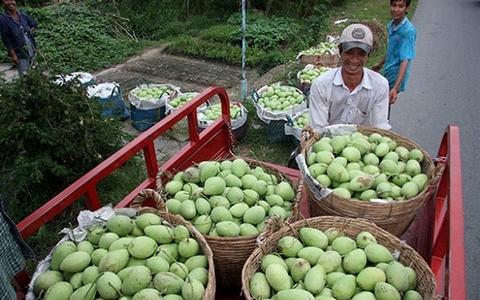
Mangoes harvested in Dong Thap Province. — Photo congthuong.vn
Viet Nam plans to expand the area under mango and production by 2030 to achieve exports of US$650 million to take advantage of the growing global demand for the fruit.
According to the Ministry of Agriculture and Rural Development’s Agro Processing and Market Development Authority, last year mango exports were worth $180 million, or 1.15 per cent of the global export share, with China according for nearly $152 million.
Viet Nam also exported to Russia, the US, Korea, the EU, Australia, and Japan.
Nguyen Dinh Tung, chairman of Vina T&T Group, which has been the fruit since 2019, said his company’s preservation technologies keep the fruit for around a month and the free trade agreements Viet Nam has signed markets is helping it enter many new markets.
Mango could be grown throughout the year without much change in quality, which helps his company easily clinch export deals, he said.
Viet Nam has around 87,000 hectares under mango, with the Mekong Delta accounting for nearly half of it.
Dong Thap Province has identified mango as a key crop in its agricultural reform plan.
The province, the largest mango producer in the delta, uses advanced farming techniques and processes fresh mangoes for both domestic consumption and export.
Pham Thien Nghia, chairman of its People's Committee, said the province has more than 12,000ha under mango, mostly in Cao Lanh District and Cao Lanh City. The Hoa Loc variety accounts for 70 per cent of its output and Cat Chu for 20 per cent, two speciality varieties that are in high demand.
Dong Thap plans to increase its area under various fruits to more than 35,000ha from 33,000ha now by 2025 with a focus on environment-friendly farming methods and developing value chains for them.
It also plans to enhance origin tracing for fruits and tourism services involving orchards.
It hopes to have 928ha of fruits grown to Vietnamese good agricultural practices (VietGAP) standards and 53ha to GlobalGAP standards.
Besides mango, longan and citrus fruits are the key produce here and they are grown in large, concentrated farming areas.
Under the province’s agriculture restructuring plan, many farmers with low-yield rice fields have switched to fruits and adopted VietGAP and GlobalGAP standards and advanced techniques to produce quality fruits that are exported.
The Government wants the delta provinces to register mango farming zones and assign codes, push for safe farming practices and carry out frequent inspections of processing and packing facilities. — VNS